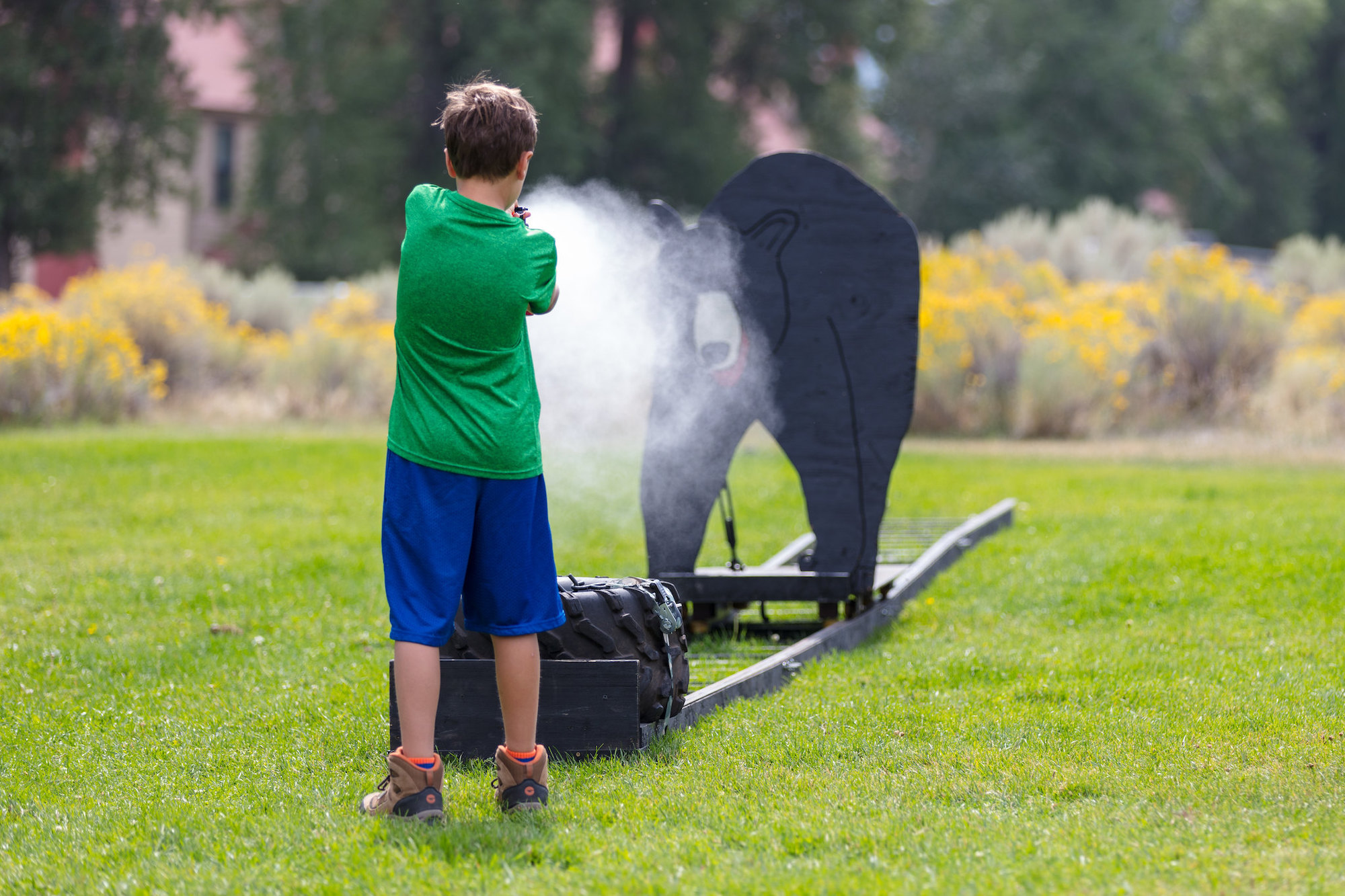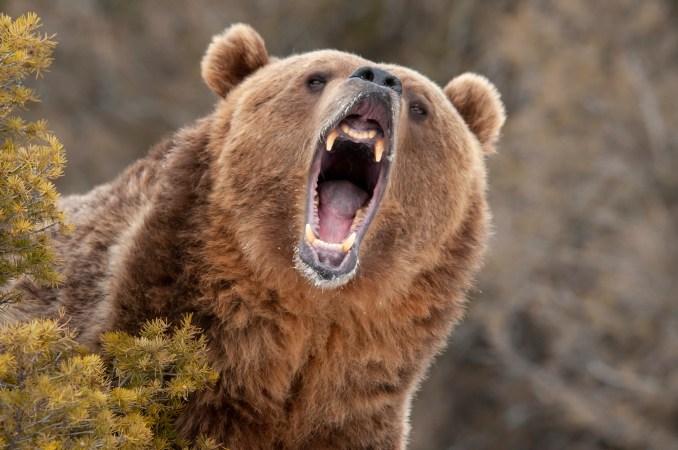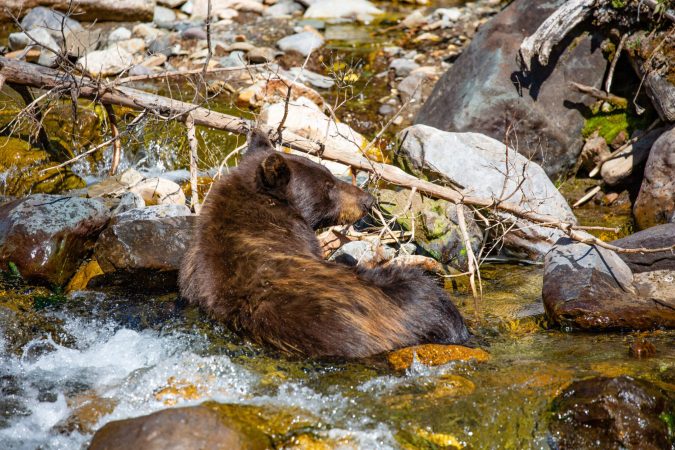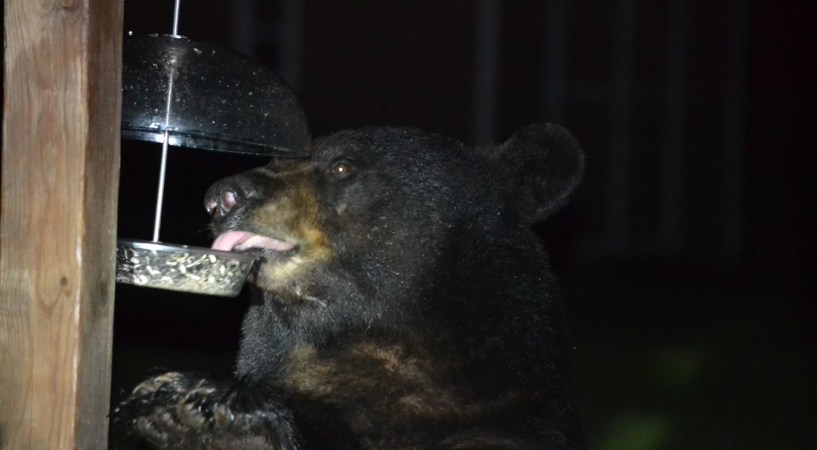Traveling in bear country calls for a heightened sense of awareness and a basic understanding of how to defend yourself from an aggressive black bear or grizzly. Carrying and knowing how to use bear spray is one of the most important and effective safety measures you can take. Studies have shown that using bear spray can reduce both the likelihood and the severity of a bear attack, and more than a few near victims have seen its effectiveness firsthand.
This includes Alan Townsend, the dean of the University of Montana’s Forestry School, and Scott Ferrenberg, associate director of UM’s Lubrecht Experimental Forest — both of whom crossed paths with a grizzly bear years ago in northwest Montana. Ferrenberg tells Outdoor Life that he and Townsend were surveying a patch of prairie near Ovando when they unknowingly roused a large male grizzly from its nap. The boar announced its presence with a growl and charged the two men.
“One of the things that stood out to me was just how large it was,” Ferrenberg says. “I’m a tall man, about 6-foot-4, but that bear … if it stood next to me [on all fours], its snout would have leveled with my sternum.”
The bear made a bluff charge at Ferrenberg and then wheeled away, turning toward Townsend instead. This gave Ferrenberg enough time to draw his own bear spray canister and spray the bear mid-charge as it closed in on Townsend. The charging grizzly spun around and retreated immediately.
“Despite the fact that my spray was deployed at the side-shoulder-head area of the bear, it was immediately effective,” Ferrenberg says. “Which impressed me.”
With that close call in mind, here’s everything you need to know about bear spray and how to use it.
What Is Bear Spray?
Bear spray is a non-lethal deterrent designed to stop a charging bear in its tracks. The active ingredient is capsicum oleoresin, which is derived from chili peppers.

When triggered, a canister of bear spray releases a dense cloud of the pepper oil. This burning blast of pressurized spice temporarily reduces a bear’s ability to breathe, see, and smell, often running it off or buying you valuable time to haul ass out of there.
Is Bear Spray Effective?
Tom Smith is an associate professor at Brigham Young University and a prominent researcher who has studied thousands of incidents that involved the use of bear spray. In a study that he published in The Journal of Wildlife Management in 2010, Smith analyzed a number of incidents that took place in Alaska. This included 61 cases involving brown bears and 20 cases involving black bears.
The study concluded that bear spray was effective in stopping undesirable behavior (including attacks and attempts to secure food or garbage) 92 percent of the time against brown bears and 90 percent of the time against black bears. Most importantly, it found that 98 percent of people who used bear spray during an encounter walked away uninjured. The remaining two percent of people only received minor injuries, which means the bear spray could have helped reduce the severity of these attacks.

“You have no business in bear country if you do not have a deterrent with you,” Smith says.
No deterrent is 100 percent effective, however. And in roughly 20 percent of the incidents analyzed in the study, wind either interfered with the accuracy of the spray or caused it to blow back in the sprayer’s face. This doesn’t necessarily mean that bear spray can fail, as there were no mechanical failures reported in any of these cases. It simply proves that any deterrent must be used properly in order to be effective against a charging bear.
How Do You Properly Use Bear Spray?

Bear spray should be used as a deterrent and not a bear repellent. Only use it when a bear shows aggressive behavior or gets too close. If that happens:
- Remove the safety clip. Before using bear spray, you need to remove the safety clip as swiftly as possible. It’s there to prevent accidental discharge, but when a bear is charging toward you, you need it gone pronto. Remove this clip quickly by wrapping your thumb over the clip and pulling it back.
- Aim. You are trying to create a barrier of spray between you and the bear. Aiming slightly below and toward the bear’s head will help ensure the bear runs into the spray. Use both hands to steady your aim.
- Consider the wind direction. Wind influences the bear spray’s direction. If you’re lucky, the wind will be at your back. If there’s a crosswind, aim slightly into the wind so the wind will carry the spray in front of the bear. If there’s a strong headwind, try to reposition yourself so you don’t end up with a face full of spray.
- Spray. When the charging bear is 20 to 30 feet away, spray a one- to two-second burst. Remember to aim slightly downward and toward the bear’s head. If you miss or spray in the wrong direction, spray again.
- Leave the area. When the bear stops or retreats, back away slowly. Do not run. Keep an eye on the bear to make sure it’s not following you. Most bears will run away once sprayed, but in some cases, bears have returned to the scene, so hustle (slowly and carefully) to safety.
“Our cans empty fast,” says Tim Lynch, the general manager of UDAP Industries, which is one of the leading manufacturers of bear spray in the U.S. “We have a high-volume, powerful spray, so with ours, you want to use short bursts.”
UDAP’s Pepper Power canisters come in different sizes, all of which have a range of 30 feet or more and a continuous spray time of five to seven seconds. Wind and temperature can affect the spray distance, and Lynch says their spray is most effective when the bear is about 15 feet away.
“If you have time and you see a bear charging in, you want to get a burst in when the bear is around 50 to 60 feet from you,” Lynch says. “If you don’t have that time, or if the bear keeps charging in, you want to spray again when the bear is quite close and just let the bear have it.”
Lynch likens the bear spray’s dispersal to a shotgun blast, and he says it’s better to aim the can in one spot rather than waving it side to side.
“We’ve been trying to correct misinformation someone put out that is recommending people do this zigzag pattern. That just destroys the push on the bear spray and then you create this huge fog cloud in front of you that would be hard to get away from if the wind changed.”
Other reputable manufacturers include Counter Assault, Mace, and SABRE. These companies make some of the best bear spray on the market, and many of their canisters come with holsters so you can keep them close at hand.
Practice Before You Visit Bear Country
Using bear spray is fairly straightforward, but an adrenaline-filled grizzly encounter is not the time to familiarize yourself with it. Practice reaching for your bear spray canister, removing it from your holster or side pocket, and quickly removing the safety clip until it becomes second nature.
“The biggest problem people have with bear spray is getting it out and getting safety off so that they can use it,” Smith says. “They fumble around or they’re looking at the bear so they can’t figure out how the safety comes off.”
Ferrenberg agrees, pointing out that he was quick to react when he sprayed the massive grizzly because he had plenty of practice.

“Take it seriously and get your practice in like any other part of getting ready for the outdoors,” says Ferrenberg. “People will practice setting up a tent many times before they go backpacking, but it’s somehow a joke to practice pulling your bear spray. It needs to be something people take as part of the routine.”
Smith strongly advises against testing the same can of spray that you plan to carry in bear country to avoid weakening the spray’s propellant. Instead, one of the best ways to practice is by using inert cans of bear spray. These are harmless, water-filled canisters that are readily available from manufacturers, and they let you test your aim in various conditions. Many bear safety classes also incorporate these inert cans into their training sessions.
Tips for Using Bear Spray
We spoke with several experts to learn more about bear spray. Here are some tips on how to use it in bear country:
- Be bear aware: Stay vigilant. Always be aware of your surroundings and look for signs of bear activity such as tracks or bear scat. Pay special attention to dense brush, tall grass, and other areas that provide cover for bears. Also note the wind direction when you’re walking.
- Keep it accessible: Always stash your bear spray within arm’s reach, like in a chest or belt holster. If a bear is charging you, you won’t have time to dig through your backpack to find a canister. Remember how fast bears can run; up to 40 mph.

“The biggest mistake that people can make with bear spray is to put it somewhere where they can’t get to it, like putting it in your pack,” says Chris Servheen, a bear biologist who spent three and half decades as the U.S. Fish and Wildlife’s grizzly recovery coordinator.
In denser brush, where visibility is limited, you should carry your bear spray in hand, ready to deploy.
- Make sure everyone in the group has bear spray. “Everybody should carry it, not just one person,” Servheen says.
- Don’t use it like insect repellent. Never apply bear spray on your skin, clothing, or gear. It’s only effective when airborne and can cause serious injury if used like insect repellent.
- Check the expiration date. Bear spray does expire. Check the date and replace as needed.
“Normally, the expiration date is three to four years out from when they’re sold,” Servheen says. “It’s worth it to just save up and buy a new can.” - Make sure your bear spray is EPA-approved. Look for canisters with an EPA registration, 1 to 2 percent capsaicin, and a range of 25 feet or more.
- Store bear spray in a cool, dry place. The inside of a hot vehicle or direct sunlight can heat a can of bear spray to a dangerous 120 degrees Fahrenheit, at which point it could explode.
Bear Spray vs. Firearms
The bear spray vs. gun debate is a divisive one. More than a few hunters have credited their firearm for saving their skin, and plenty of folks would opt for a gun over a can of bear spray every time. (Whether that’s a rifle chambered in a reliable bear cartridge, a 12 gauge loaded with slugs, or a bear defense handgun depends on the shooter and the setting.) But while guns can certainly kill a bear, their effectiveness as a defensive tool boils down to the shooter’s ability to maintain accuracy in a high-adrenaline situation.
Smith and other researchers took a closer look at this in another study that was published in 2012. After examining 269 encounters between 357 bears (brown, black, and polar) and 444 humans, the study concluded that people who used firearms for self-defense against bears “suffered the same injury rates in close encounters with bears whether they used their firearms or not.”
The study did not indicate how well trained those people were with their firearms. But it concluded that most people traveling in bear country are better off using bear spray. Smith and other bear experts have all reached the same conclusion, and they emphasize the challenges of being safe and accurate with a firearm during an attack.
“The vast majority of people are much better off with bear spray than they are with a firearm,” Smith says. “The problem is [shot] placement under extraordinary duress. Most people I’ve talked to train at firing ranges. That’s different than when the paper target jumps down off the rack and chases you with a threat of killing you.”
When Townsend and Ferrenberg were charged by the grizzly in Montana, both men were carrying sidearms and cans of bear spray. Townsend debated which one to reach for, then caught his hand in the straps of his binoculars when he reached across his body for his sidearm. The bear was only a few feet away from him when Ferrenberg sprayed it.
“One of the mistakes I made was not having the absolute quick instinct of which I was going to go for first and why,” Townsend says. “It was just so fast and out of nowhere. I just instinctively reached for the firearm instead.”

Townsend says that he and Ferrenberg still carry both firearms and bear spray. But the two have since agreed to reach for bear spray as their “first, second, and third choice,” while keeping their firearms as a backup for other worst case scenarios.
“As someone who is frequently carrying a firearm as part of what I’m doing, I would go for the bear spray every time,” Ferrenberg says. “You’d need to quick-draw, get on target, and fire off a round in a fraction of a second, and that’s just not realistic when a 500-pound animal is charging at you.”
Perhaps, then, one answer to the bear spray vs. gun debate is to carry both and use spray as the first line of defense. Alaska game wardens and backcountry rangers already do this, typically carrying a shotgun with slugs along with a holstered can of bear spray.
As a final point of consideration, Lynch points out that using bear spray can help avoid situations where a bear doesn’t necessarily need to be killed. One example would be shooting a sow with cubs when a blast of spray could effectively turn the bears around.
“Even if you’re bear hunting, you might not want to take that particular bear,” Lynch says. “It’s a tool, just like a firearm, and every tool has its use and its need.”
FAQs
When the charging bear is 20 to 30 feet away, aim and spray a short burst for 1 to 2 seconds.
“The goal is to get short bursts, not to spray the entire can at once,” Lynch said. “It’s not like a fire extinguisher where the whole thing empties. You can control the amount and it’s designed to be sprayed in short bursts.”
It’s also important to know your bear spray and read the label, as some cans could take longer to empty.
Bear spray affects humans much like it does bears. The red pepper derivatives can cause swelling and irritation of the eyes, nose, and lungs. If you get sprayed in the face, you may not be able to open your eyes, have an extreme case of a runny nose, and experience a coughing fit. It’s painful, but the effects are temporary if treated properly.
If you are sprayed, wash all affected areas with cool, clean water, remove contact lenses, and wash contaminated clothing immediately. Take short shallow breaths to avoid inhaling the spray. It will likely take at least 15 to 20 minutes before you experience any relief. If symptoms persist, seek medical attention.
The 2008 study found that bear spray was effective in halting undesirable behavior of black bears 90 percent of the time. The study defined failures as incidents in which the bear continued its pursuit, persisted in attempts to acquire food or garbage, or showed no change in other undesirable behaviors.
Bear spray has a strong odor, and it smells like the hot peppers from which the active ingredient is derived. Because it is a food-based substance, this smell may actually attract a bear if it’s used improperly (i.e. like insect repellent).
Final Thoughts on Bear Spray
Bear spray is an invaluable tool when traveling in bear country, but carrying a can is useless if you don’t know how to use it. Familiarize yourself with your bear spray, put it in an accessible place, and practice pulling it. You can also practice with inert cans of bear spray so you’re ready if the time ever comes to use it.
















